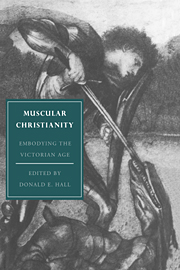Book contents
- Frontmatter
- Contents
- List of contributors
- Acknowledgments
- INTRODUCTION
- PART I FOUNDATIONS OF MUSCULAR CHRISTIANITY
- PART II VARIETIES OF MUSCULAR CHRISTIANITY
- PART III RESPONSES TO MUSCULAR CHRISTIANITY
- 8 The confidence man: empire and the deconstruction of muscular Christianity in The Mystery of Edwin Drood
- 9 The re-subjection of “Lucas Malet”: Charles Kingsley's daughter and the response to muscular Christianity
- 10 Pater's muscular aestheticism
- Index
10 - Pater's muscular aestheticism
from PART III - RESPONSES TO MUSCULAR CHRISTIANITY
Published online by Cambridge University Press: 05 March 2010
- Frontmatter
- Contents
- List of contributors
- Acknowledgments
- INTRODUCTION
- PART I FOUNDATIONS OF MUSCULAR CHRISTIANITY
- PART II VARIETIES OF MUSCULAR CHRISTIANITY
- PART III RESPONSES TO MUSCULAR CHRISTIANITY
- 8 The confidence man: empire and the deconstruction of muscular Christianity in The Mystery of Edwin Drood
- 9 The re-subjection of “Lucas Malet”: Charles Kingsley's daughter and the response to muscular Christianity
- 10 Pater's muscular aestheticism
- Index
Summary
I could wish I were an Apollo for His sake! Strange idea, yet it seems so harmonious to me!
Charles KingsleyMy title gestures towards a conjunction of two writers, Charles Kingsley and Walter Pater, that to most readers will probably seem an implausible pairing, save as an exercise in parody. What figure is more remote from Kingsley's muscular Christian than the Paterian aesthete? Yet the two figures arise out of a common project, the reclamation of the body from the antagonisms of an orthodox, ascetic morality. What was at issue in Kingsley's quarrel with Newman, as many scholars have pointed out, was not so much mendacity as sexuality. Newman's “Manichaeism” was a standing affront to Kingsley's insistence on the sanctity of the flesh – disturbing precisely because it challenged the hard-won and precarious resolution of Kingsley's struggles with his own sexuality. Pater, too, begins his career by decrying the war between flesh and spirit. His first and most famous work, The Renaissance (1873), takes as its subject the historical period that marks, as Pater put it, man's “reassertion of himself, that rehabilitation of human nature, the body, the senses, the heart, the intelligence” in opposition to a medieval tendency “to depreciate man's nature … to make it ashamed of itself” (31). Pater's most vivid emblem of this “rehabilitation” is the recovery of Greek sculpture, an achievement to which he returns throughout his writings in celebrations of the male body.
- Type
- Chapter
- Information
- Muscular ChristianityEmbodying the Victorian Age, pp. 215 - 238Publisher: Cambridge University PressPrint publication year: 1994
- 2
- Cited by



